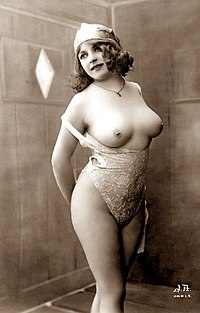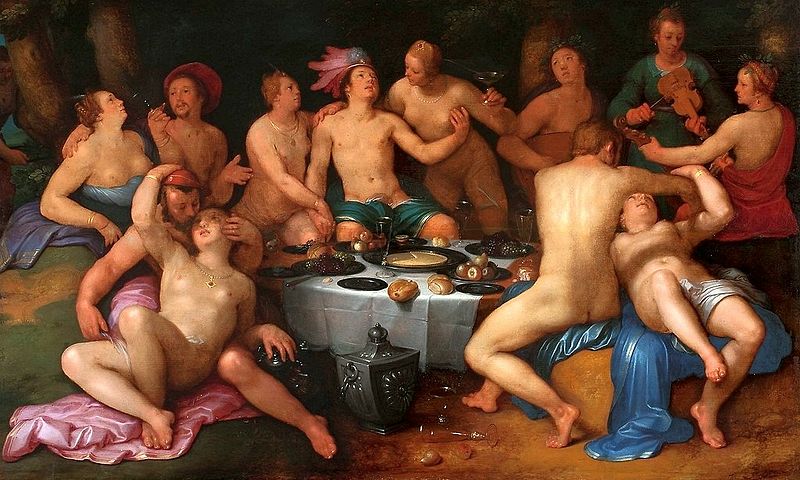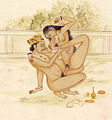Portal:Erotica and pornography
Introduction

Pornography (colloquially known as porn or porno) has been defined as sexual subject material "such as a picture, video, or text" that is intended for sexual arousal. Made for the consumption by adults, pornography depictions have evolved from cave paintings, some forty millennia ago, to virtual reality presentations. A general distinction of adult content is made classifying it as pornography or erotica.
The oldest artifacts considered pornographic were discovered in Germany in 2008 CE and are dated to be at least 35,000 years old. Throughout the history of erotic depictions various people made attempts to suppress them under obscenity laws, censor, or make them illegal. Such grounds and even the definition of pornography have differed in various historical, cultural, and national contexts. The Indian Sanskrit text Kama Sutra (3rd century CE) contained prose, poetry, and illustrations regarding sexual behavior, and the book was celebrated; while the British English text Fanny Hill (1748), considered "the first original English prose pornography," has been one of the most prosecuted and banned books. In the late 19th century, a film by Thomas Edison that depicted a kiss was denounced as obscene in the United States, whereas Eugène Pirou's 1896 film Bedtime for the Bride was received very favorably in France. Starting from the mid-twentieth century on, societal attitudes towards sexuality became more lenient in the Western world where legal definitions of obscenity were made limited. In 1969, Blue Movie became the first film to depict unsimulated sex that received a wide theatrical release in the United States. This was followed by the "Golden Age of Porn" (1969–1984). The introduction of home video and the World Wide Web in the late 20th century led to global growth in the pornography business. Beginning in the 21st century, greater access to the Internet and affordable smartphones made pornography more mainstream. (Full article...)
Erotica is literature or art that deals substantively with subject matter that is erotic, sexually stimulating or sexually arousing. Some critics regard pornography as a type of erotica, but many consider it to be different. Erotic art may use any artistic form to depict erotic content, including painting, sculpture, drama, film or music. Erotic literature and erotic photography have become genres in their own right. Erotica also exists in a number of subgenres including gay, lesbian, women's, bondage, monster and tentacle erotica.
The term erotica is derived from the feminine form of the ancient Greek adjective: ἐρωτικός (erōtikós), from ἔρως (érōs)—words used to indicate lust, and sexual love. (Full article...)
Selected article

Pink film (ピンク映画, Pinku eiga) refers in Japan to movies produced by independent studios that includes nudity (hence 'pink') or deals with sexual content. This encompasses everything from dramas to action thrillers and exploitation film features. Many pink films would be analogous to erotic thrillers, e.g. Fatal Attraction, Fifty Shades of Grey, Basic Instinct, 9½ Weeks.
Independent studios that release pink films include OP Eiga, Shintōhō Eiga, Kokuei and Xces. The phrase 'pink film' came into use after the major Toei began advertising some of its movies as 'porno' in 1971, and other major Nikkatsu switched to producing only Roman Porno films later that year.
Until the early 2000s, they were almost exclusively shot on 35 mm film. Recently, filmmakers have increasingly used video (while retaining their emphasis on soft-core narrative). Many theaters swapped 35mm for video projectors and began relying on old videos to meet the demand of triple-feature showings. (Full article...)Selected work of erotic literature
Ada or Ardor: A Family Chronicle is a novel by Vladimir Nabokov published in 1969.
Ada began to materialize in 1959, when Nabokov was flirting with two projects, "The Texture of Time" and "Letters from Terra." In 1965, he began to see a link between the two ideas, finally composing a unified novel from February 1966 to October 1968. The published cumulation would become his longest work. Ada was initially given a mixed reception. However, writing in The New York Times Book Review, noted scholar Alfred Appel called it "a great work of art, a necessary book, radiant and rapturous," and said that it "provides further evidence that he is a peer of Kafka, Proust and Joyce." (Full article...)Slideshow of selected contemporary images
Slideshow of selected historical images
Did you know (auto-generated) -

- ... that a pornographic screenplay about Jesus led to papal and royal condemnations, a firebombing, the writer's ban from the UK, and thousands of letters per week demanding the ban of a non-existent gay Jesus film?
- ... that Lewes Road in Brighton has a gyratory named after a pornographic cinema?
- ... that zombie pornography emerged in the 1980s during a rise in the Italian sexploitation film industry?
- ... that before being restored as a Broadway theater, the Ritz Theatre was used as a television studio, pornographic theater, vaudeville house, children's theater, and poster warehouse?
- ... that according to one source, The Embroidered Couch is "most likely China's earliest vernacular pornographic novel"?
- ... that Aroha Bridge changed its name from Hook Ups because fans searching for the show often found pornography instead?
- ... that John Wayne Bobbitt Uncut was the bestselling pornographic film of 1994 and had the most rentals that year in the United States?
- ... that Money Shot: The Pornhub Story was described by multiple reviewers as unsalacious?
Topics
Categories
Related portals
Associated WikiProjects
 |
 |
| Sexology and sexuality | Pornography |
Associated Wikimedia
The following Wikimedia Foundation sister projects provide more on this subject:
-
Commons
Free media repository -
Wikibooks
Free textbooks and manuals -
Wikidata
Free knowledge base -
Wikinews
Free-content news -
Wikiquote
Collection of quotations -
Wikisource
Free-content library -
Wikiversity
Free learning tools -
Wiktionary
Dictionary and thesaurus


























































![Image 7Indian Princess, by Richard Borrmeister [de] (1888?)](http://upload.wikimedia.org/wikipedia/commons/thumb/0/01/Richard_Borrmeister_Indische_Prinzessin_1888.jpg/102px-Richard_Borrmeister_Indische_Prinzessin_1888.jpg)













































